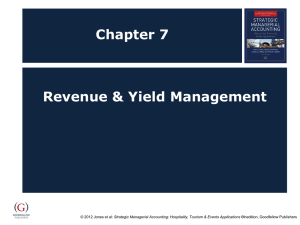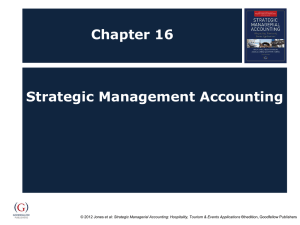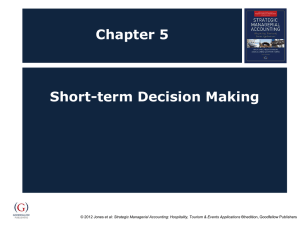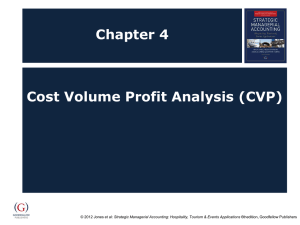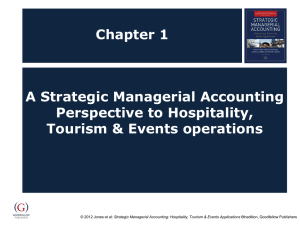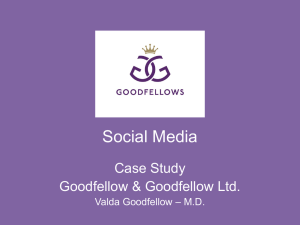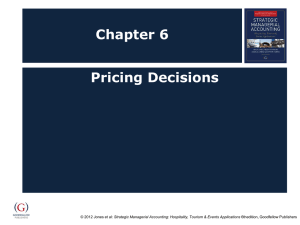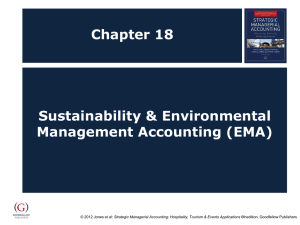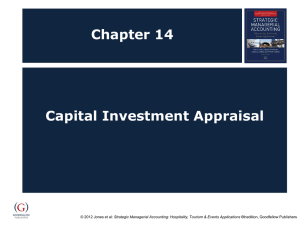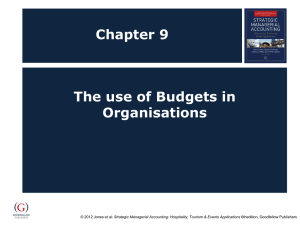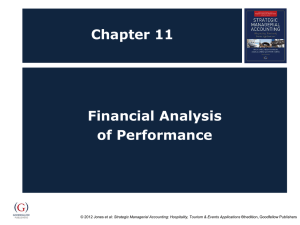Chapter 3 - Goodfellow Publishers
advertisement
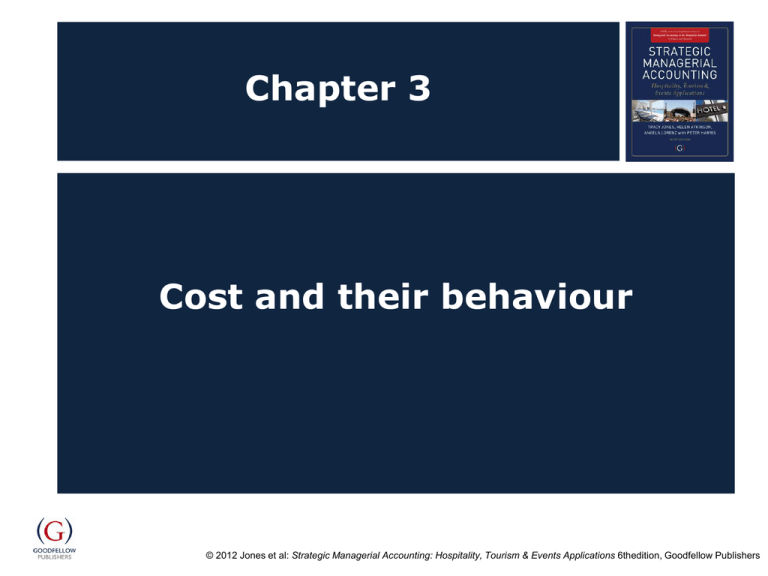
Chapter 3 Cost and their behaviour © 2012 Jones et al: Strategic Managerial Accounting: Hospitality, Tourism & Events Applications 6thedition, Goodfellow Publishers Objectives After studying this topic you should be able to: Understand a range of cost concepts that underpin decision-making Identify the elements of cost and the main ways of classifying costs Understand what is meant by direct/indirect; variable/fixed costs Be able to apply these cost concepts Understand the implications of different cost structures. © 2012 Jones et al: Strategic Managerial Accounting: Hospitality, Tourism & Events Applications 6thedition, Goodfellow Publishers Classifying Costs © 2012 Jones et al: Strategic Managerial Accounting: Hospitality, Tourism & Events Applications 6thedition, Goodfellow Publishers Classifying Costs Basic Elements of Cost - identified in terms of the basic resources of materials, labour and expenses necessary to produce a product or service Direct and Indirect Costs - attributed or assigned to a specific product or service. This method of classification is used for management control purposes Cost behaviour - relating to behaviour, how costs behave in different circumstances. Probably the most useful and important for managers, used for management planning and decision-making. © 2012 Jones et al: Strategic Managerial Accounting: Hospitality, Tourism & Events Applications 6thedition, Goodfellow Publishers Direct and Indirect Costs Cost Food Context Restaurant Fuel Costs Airlines Energy Hotel Marketing and Advertising Event Classification Direct – food cost of meals sold to customers Indirect – Food cost of meals provided for staff. Direct – fuelling a plane Indirect – Fuelling ground vehicles. Direct – Metered gas in kitchens Indirect – general lighting of public areas Direct – advertising specific one off event Indirect – Company promotion at wedding fair © 2012 Jones et al: Strategic Managerial Accounting: Hospitality, Tourism & Events Applications 6thedition, Goodfellow Publishers Absorption Costing Absorption costing is an approach to costing that attempts to identify the full cost of a product or service. Determining full costs requires the identification of direct costs and the allocation of indirect costs. This can be used to help set prices and evaluate profitability. The basis of allocation can affect the cost, e.g. on a cruise liner per cabin, or per meter squared of cabin space, will yield different results. © 2012 Jones et al: Strategic Managerial Accounting: Hospitality, Tourism & Events Applications 6thedition, Goodfellow Publishers Variable Cost A variable cost in total varies in direct proportion to changes in volume of activity © 2012 Jones et al: Strategic Managerial Accounting: Hospitality, Tourism & Events Applications 6thedition, Goodfellow Publishers Fixed Cost A fixed cost is one which in total accrues in relation to the passage of time and that, within limits, tends to be unaffected by fluctuations in activity (output or turnover) © 2012 Jones et al: Strategic Managerial Accounting: Hospitality, Tourism & Events Applications 6thedition, Goodfellow Publishers Semi-variable Cost Semi-variable (or mixed) costs that contain both fixed and variable elements, so is partly affected by fluctuations in volume activity. © 2012 Jones et al: Strategic Managerial Accounting: Hospitality, Tourism & Events Applications 6thedition, Goodfellow Publishers Relevant Range Assumptions about cost behaviour can only be reliable within specific circumstances and particular range of activity. This specific range of activity is called the relevant range. Behaviour of costs outside this range of activity is unknown and likely to change. © 2012 Jones et al: Strategic Managerial Accounting: Hospitality, Tourism & Events Applications 6thedition, Goodfellow Publishers Relevant Range © 2012 Jones et al: Strategic Managerial Accounting: Hospitality, Tourism & Events Applications 6thedition, Goodfellow Publishers Cost functions and cost estimation Cost behaviours have been shown as linear cost functions, i.e. take the form of a continuous straight line In reality cost functions are usually curvilinear but then cost computations can become extremely complex . Linear approximations have been found to be realistic interpretations of cost behaviour patterns; these are used for decision making. There are three key methods for estimating costs:- High/Low, Scattergraph and Linear Regression. © 2012 Jones et al: Strategic Managerial Accounting: Hospitality, Tourism & Events Applications 6thedition, Goodfellow Publishers Cost functions and cost estimation Figure 3.7 Comparison of high/low and scatter graphs © 2012 Jones et al: Strategic Managerial Accounting: Hospitality, Tourism & Events Applications 6thedition, Goodfellow Publishers Total costs and unit costs Cost can be presented and interpreted in two ways, as total costs or as a single unit of cost. The behaviour of costs depends on the whether the focus is on total or unit costs. Total Fixed costs remains the same as volume increases, but the unit FC decreases. Total variable costs increases as volume increases but the unit variable cost stays the same. © 2012 Jones et al: Strategic Managerial Accounting: Hospitality, Tourism & Events Applications 6thedition, Goodfellow Publishers Total costs and unit costs © 2012 Jones et al: Strategic Managerial Accounting: Hospitality, Tourism & Events Applications 6thedition, Goodfellow Publishers Illustrative Example: Paris Tours Paris Tours is a small business that offers full day coach trips around Paris city centre and surrounding area. The standard guided tour includes full day coach tour around Paris, with access to the Eiffel Tower, lunch and entry to the Louvre in the afternoon. The following forecasts have been prepared for the forthcoming year at varying volumes of activity; low, medium and high. From the data below it is possible to:1. Identify Variable costs, Fixed Costs and Semi variable. 2. Separate out the fixed and variable element of the semi variable costs 3. Work out what the profit would be if they sold 15,000 tours. © 2012 Jones et al: Strategic Managerial Accounting: Hospitality, Tourism & Events Applications 6thedition, Goodfellow Publishers Illustrative Example © 2012 Jones et al: Strategic Managerial Accounting: Hospitality, Tourism & Events Applications 6thedition, Goodfellow Publishers Illustrative Example Paris Tours 1. Identify Variable costs, Fixed Costs and Semi variable. Overheads are fixed Entrance Fees are variable because there is a direct change €108,000 ÷ 12,000 = €9.00 x 14,000 = €126,000. Food and Refreshments also change in direct proportion, working from high forecast to medium €192,000 ÷ 16,000 x 14,000 = € 168,000 (the medium cost for F&R). Wages and Salaries are not variable 2. Separate out the fixed and variable element of the semi variable costs 3. Work out what the profit would be if they sold 15,000 tours. © 2012 Jones et al: Strategic Managerial Accounting: Hospitality, Tourism & Events Applications 6thedition, Goodfellow Publishers Illustrative Example Paris Tours 2. Separate out the fixed and variable element of the semi variable costs © 2012 Jones et al: Strategic Managerial Accounting: Hospitality, Tourism & Events Applications 6thedition, Goodfellow Publishers Illustrative Example Paris Tours 3. Work out what the profit would be if they sold 15,000 tours. © 2012 Jones et al: Strategic Managerial Accounting: Hospitality, Tourism & Events Applications 6thedition, Goodfellow Publishers Cost structure and operational gearing Cost structure refers to the relationship between fixed and variable costs. Some business’s costs are mainly variable and other businesses exhibit a majority of fixed costs. It is derived from the nature of the business itself and the way it was set up. This is a relative scale, where the focus is on the proportion of total costs that are either fixed or variable. © 2012 Jones et al: Strategic Managerial Accounting: Hospitality, Tourism & Events Applications 6thedition, Goodfellow Publishers Cost structure and operational gearing Cost structure is important because it affects the volatility of profits. Companies with high fixed costs experience greater variation in profits, relative to similar companies with low fixed costs. When sales increase profit increase faster and further with high fixed costs companies, but when sales decrease profit decreases further too. Cost structure leads to a market orientation or a cost orientation in businesses. © 2012 Jones et al: Strategic Managerial Accounting: Hospitality, Tourism & Events Applications 6thedition, Goodfellow Publishers Cost structure and operational gearing © 2012 Jones et al: Strategic Managerial Accounting: Hospitality, Tourism & Events Applications 6thedition, Goodfellow Publishers Cost structure and operational gearing © 2012 Jones et al: Strategic Managerial Accounting: Hospitality, Tourism & Events Applications 6thedition, Goodfellow Publishers Cost structure - industry examples © 2012 Jones et al: Strategic Managerial Accounting: Hospitality, Tourism & Events Applications 6thedition, Goodfellow Publishers Summary Costs are the value of resources used up in the production of products and services and there are several ways of sub-dividing costs. Analysing cost behaviour reveals variable and fixed costs, which are fundamental to many management accounting techniques. A variety of costing techniques have been developed, including absorption and marginal costing, which are utilised in different decision contexts. Costs can be reported as unit values or in total, it is very important to understand the difference and the nature of any data used in decision making. The cost structure of a firm has significant impact on the market orientation and risk of the business. © 2012 Jones et al: Strategic Managerial Accounting: Hospitality, Tourism & Events Applications 6thedition, Goodfellow Publishers
